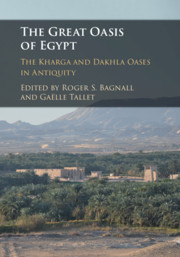Book contents
- The Great Oasis of Egypt
- The Great Oasis of Egypt
- Copyright page
- Contents
- Figures
- Tables
- Contributors
- Preface
- 1 Introduction
- Part I Living in the Oasis: Humans and the Environment
- Part II Managing the Oasis
- Part III Trade and Mobility in a Connected Environment
- 8 The North Kharga Oasis Darb Ain Amur Survey (NKODAAS): Surveying the Tracks between the Two Oases
- 9 And the Potsherds? Some Avenues of Reflection and Synthesis on the Pottery of the Great Oasis
- 10 Egyptian and Imported Amphoras at Amheida
- 11 Kegs from Amheida
- 12 El-Deir as a Switching Point
- Part IV An Oasis Culture?
- Bibliography
- Index of ancient people
- Index of places
- General index
11 - Kegs from Amheida
from Part III - Trade and Mobility in a Connected Environment
Published online by Cambridge University Press: 12 July 2019
- The Great Oasis of Egypt
- The Great Oasis of Egypt
- Copyright page
- Contents
- Figures
- Tables
- Contributors
- Preface
- 1 Introduction
- Part I Living in the Oasis: Humans and the Environment
- Part II Managing the Oasis
- Part III Trade and Mobility in a Connected Environment
- 8 The North Kharga Oasis Darb Ain Amur Survey (NKODAAS): Surveying the Tracks between the Two Oases
- 9 And the Potsherds? Some Avenues of Reflection and Synthesis on the Pottery of the Great Oasis
- 10 Egyptian and Imported Amphoras at Amheida
- 11 Kegs from Amheida
- 12 El-Deir as a Switching Point
- Part IV An Oasis Culture?
- Bibliography
- Index of ancient people
- Index of places
- General index
Summary
This chapter discusses the typology, quantification, production, and economic implications of the ceramic vessels called kegs or sigas from the site of Amheida (ancient Trimithis) in the Dakhleh Oasis. The quantification of the ceramics undertaken at the site during the excavation seasons of 2004-10 shows a high quantity of these locally produced vessels, which suggests an important ceramic production. Furthermore, their presence found along trade routes, namely on the road to the oasis of Farafra, points to their role in commercial activities and long-distance trade of oasis products, most likely olive oil, a commodity known to have been produced in the oasis whose value as cash crop was of great consequence to the overall oasis economy.
- Type
- Chapter
- Information
- The Great Oasis of EgyptThe Kharga and Dakhla Oases in Antiquity, pp. 192 - 200Publisher: Cambridge University PressPrint publication year: 2019
- 1
- Cited by

